
The Ericaceae are a family of flowering plants, commonly known as the heath or heather family, found most commonly in acidic and infertile growing conditions. The family is large, with about 4,250 known species spread across 124 genera, making it the 14th most species-rich family of flowering plants. The many well known and economically important members of the Ericaceae include the cranberry, blueberry, huckleberry, rhododendron, and various common heaths and heathers.

The Rutaceae is a family, commonly known as the rue or citrus family, of flowering plants, usually placed in the order Sapindales.
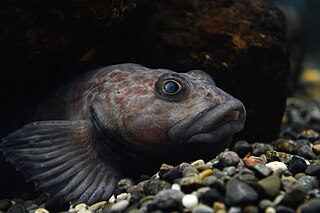
The Abyssocottinae are a subfamily of ray-finned fishes in the family Cottidae, the sculpins. They are known commonly as the deep-water sculpins. The entire subfamily is endemic to Lake Baikal in Siberia.

Myrtaceae, the myrtle family, is a family of dicotyledonous plants placed within the order Myrtales. Myrtle, pōhutukawa, bay rum tree, clove, guava, acca (feijoa), allspice, and eucalyptus are some notable members of this group. All species are woody, contain essential oils, and have flower parts in multiples of four or five. The leaves are evergreen, alternate to mostly opposite, simple, and usually entire. The flowers have a base number of five petals, though in several genera, the petals are minute or absent. The stamens are usually very conspicuous, brightly coloured, and numerous.

The Colletidae are a family of bees, and are often referred to collectively as plasterer bees or polyester bees, due to the method of smoothing the walls of their nest cells with secretions applied with their mouthparts; these secretions dry into a cellophane-like lining. The five subfamilies, 54 genera, and over 2000 species are all evidently solitary, though many nest in aggregations. Two of the subfamilies, Euryglossinae and Hylaeinae, lack the external pollen-carrying apparatus that otherwise characterizes most bees, and instead carry the pollen in their crops. These groups, and most genera in this family, have liquid or semiliquid pollen masses on which the larvae develop.

Lepismatidae is a family of primitive wingless insects with about 190 described species. This family contains the two most familiar members of the order Zygentoma: the silverfish and the firebrat. It is one of five families in the order Zygentoma.
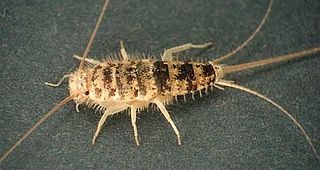
Zygentoma are an order in the class Insecta, and consist of about 550 known species. The Zygentoma include the so-called silverfish or fishmoths, and the firebrats. A conspicuous feature of the order are the three long caudal filaments. The two lateral filaments are cerci, and the medial one is an epiproct or appendix dorsalis. In this they resemble the Archaeognatha, although the cerci of Zygentoma, unlike in the latter order, are nearly as long as the epiproct.
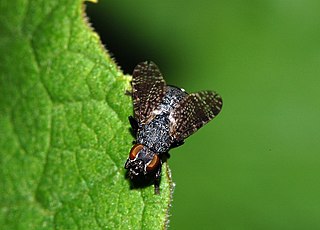
The Platystomatidae are a distinctive family of flies (Diptera) in the superfamily Tephritoidea.
A silverfish is a wingless insect in the order Zygentoma. The same name can be applied to many species in the order as a whole, which comprises the families Lepismatidae, Nicoletiidae, Lepidotrichidae, Maindroniidae and Protrinemuridae.

Camaenidae is a family of air-breathing land snails, terrestrial pulmonate gastropod mollusks in the superfamily Helicoidea, the typical snails and their allies. This is one of the most diverse families in the clade Stylommatophora.

Lepidotrichidae is a family of basal insects belonging to the order Zygentoma The family contains the extinct Lepidotrix, known from specimens preserved in Eocene aged European amber. The extant genus Tricholepidion, which contains a single species, Tricholepidion gertschi from western North America, has also been typically considered a member of the family. However, some more recent research has suggested that the two genera are not particularly closely related, and Tricholepidion should instead be assigned to its own family Tricholepidiidae.
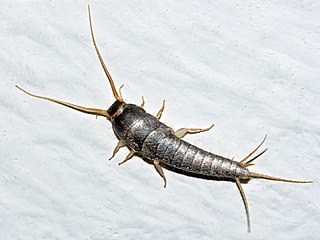
The silverfish is a species of small, primitive, wingless insect in the order Zygentoma. Its common name derives from the insect's silvery light grey colour, combined with the fish-like appearance of its movements. The scientific name indicates that the silverfish's diet consists of carbohydrates such as sugar or starches. While the common name silverfish is used throughout the global literature to refer to various species of Zygentoma, the Entomological Society of America restricts use of the term solely for Lepisma saccharinum.

Nicoletiidae is a family of primitive insects belonging to the order Zygentoma. These insects live primarily underground, under detritus, or in caves. A few species are recorded as commensals inside nests of social insects, such as the species Allotrichotriura saevissima which lives inside fire ant nests. Nicoletiids lack eyes and they lack pigmentation. They have long antennae and terminal abdominal filaments. Coletinia, a genus of this family, range in size between 10 and 15mm, and may have yellowish pigmentation but most species are transparent.

Byrrhidae, the pill beetles, is a family of beetles in the superfamily Byrrhoidea. They are generally found in damp habitats within cooler-high latitude regions of both hemispheres. Most byrrhids feed on moss, lichens and algae, though some species feed on vascular plants. The oldest undoubted record of the family is Lidryops from the earliest Late Cretaceous Charentese amber of France, with other less certain records going back to the Middle Jurassic, but these possibly belong to Byrrhoidea. There around 500 extant species in 40 genera.

Geophilidae is a family of soil centipedes in the superfamily Geophiloidea and the order Geophilomorpha. In 2014, a phylogenetic analysis based on morphological and molecular data found this family to be polyphyletic. To avoid this polyphyly, authorities dismissed the families Aphilodontidae, Dignathodontidae, Linotaeniidae, and Macronicophilidae, which are now deemed to be junior synonyms for Geophilidae. Authorities also moved some genera from Geophilidae to form the family Zelanophildae in order to avoid the polyphyly of the family Geophilidae. The family Geophilidae now includes more than 650 species in more than 120 genera. This family has a cosmopolitan distribution, with species found almost worldwide.
Texoreddellia is a genus of nicoletiids in the family Nicoletiidae, containing one described species, Texoreddellia texensis.
Protrinemuridae is a family of primitive insects belonging to the order Zygentoma. The family was previously classified as a subfamily of the Nicoletiidae, but raised to family level in 2002.
Protrinemura is a genus of silverfishes in the family Protrinemuridae. Three species are currently known:
Protrinemurella is a genus of silverfish in the family Protrinemuridae. It comprises only the type species Protrinemurella allacrotelsoidesMendes, 2002, known from Thailand's Krabi province.
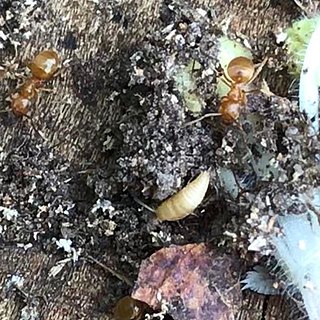
Atelura formicaria is a species of nicoletiid in the family Nicoletiidae.















